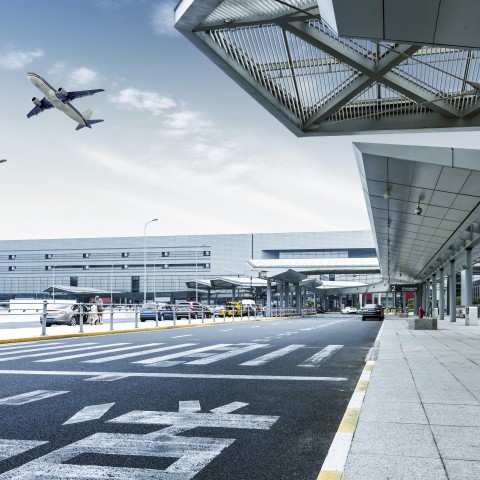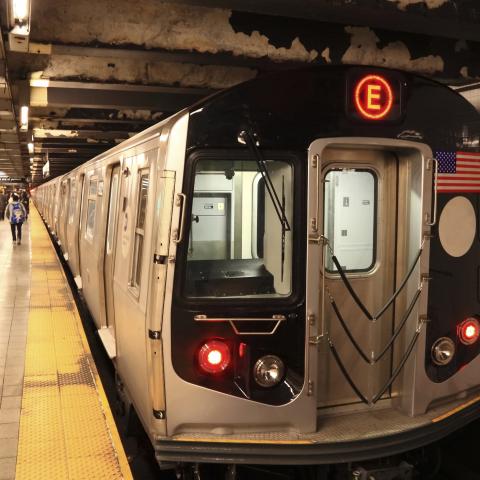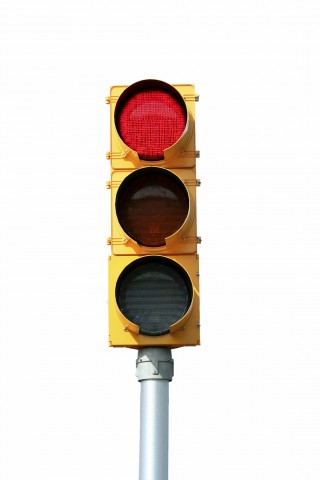
Where’s the bus stop? How do you get to this place?
Learning about Thai directions will make your travels in Thailand much easier. Further, knowing how to ask directions in Thai, and how to give them, is essential if you live or work in Thailand.
This article will help you successfully learn about directions in the Thai language. You’ll get to learn Thai vocabulary related to directions, such as “right” and “left” in Thai. In addition, you’ll be able to see how giving directions in Thai works through various sentences and phrases throughout this article. By the end of the lesson, you’ll be able to ask and give directions in Thai with ease.
 Table of Contents
Table of Contents
- On the Map: Compass Directions in Thai
- On the Road
- Landmarks
- Basic Grammar for Conversations
- Must-know Phrases and Sentences to Ask Directions in Thai
- Must-know Phrases and Sentences to Give Directions in Thai
- Real Situation Example
- Conclusion
1. On the Map: Compass Directions in Thai
The map is an important tool when it comes to asking and giving directions. Still, you should know that Thai people won’t tell you to go north or south when giving directions in Thai. ทิศ (thít), which is “direction” in Thai, is often used to tell the region of province in Thai conversations.

That said, here are the most basic words related to maps that you should know!
1- Region
Thai word: ภาค (phâak)
Usage: ภาค (phâak) is often followed by the direction.
Example:
ประเทศไทยมี 5 ภาค
Bprà-thêet-thai mii hâa phâak
“There are five regions in Thailand.”
2- Central
Thai word: กลาง (glaang)
Usage: As mentioned above, ภาค (phâak) is often followed by the direction. So Thai people use the word ภาคกลาง (phâak-glaang).
Example:
กรุงเทพอยู่ภาคกลางของประเทศไทย
Grung-thêep yùu phâak-glaang khǎawng bprà-thêet-thai
“Bangkok is in the central region of Thailand.”
3- North
Thai word: เหนือ (nǔuea)
Usage: As mentioned above, ภาค (phâak) is often followed by the direction. So Thai people use the word ภาคเหนือ (phâak-nǔuea).
Example:
ตอนหน้าหนาว อากาศที่ภาคเหนือดีมาก
Dtaawn nâa-nǎao aa-gàat thîi phâak-nǔuea dii mâak
“In winter, the weather in the north is very good.”
4- East
Thai word: ตะวันออก (dtà-wan-àawk)
Usage: ภาค (phâak) is often followed by the direction. So Thai people use the word ภาคตะวันออก (phâak-dtà-wan-àawk).
Example:
ภาคตะวันออกของไทยมีทะเลสวย
Phâak-dtà-wan-àawk khǎawng thai mii thá-lee sǔuai
“The east part of Thailand has a beautiful sea.”
5- West
Thai word: ตะวันตก (dtà-wan-dtòk)
Usage: ภาค (phâak) is often followed by the direction. So Thai people use the word ภาคตะวันตก (phâak-dtà-wan-dtòk).
Example:
ภาคตะวันตกของไทยอยู่ติดพม่า
Phâak-dtà-wan-dtòk khǎawng thai yùu dtìt phá-mâa
“The west part of Thailand is next to Myanmar.”
6- South
Thai word: ใต้ (dtâi)
Usage: ภาค (phâak) is often followed by the direction. So Thai people use the word ภาคใต้ (phâak-dtâi).
Example:
นักท่องเที่ยวชอบไปที่ภาคใต้ของไทย
Nák-thâawng-thîiao châawp bpai thîi phâak-dtâi khǎawng thai
“Travelers like to go to the south of Thailand.”
7- Northeast
Thai word: ตะวันออกเฉียงเหนือ (dtà-wan-àawk-chǐiang-nǔuea)
Usage: ภาค (phâak) is often followed by the direction. So Thai people use the word ภาคตะวันออกเฉียงเหนือ (dtà-wan-àawk-chǐiang-nǔuea).
Example:
ภาคตะวันออกเฉียงเหนือของไทยอากาศร้อนเกือบตลอดปี
Phâak-dtà-wan-àawk-chǐiang-nǔuea khǎawng thai aa-gàat ráawn gùueap dtà-làawt bpii
“The weather of the northeast part of Thailand is hot almost all year.”
Additional Information: The northeast part of Thailand has another name, which is ภาคอีสาน (phâak-ii-sǎan).
8- Upper part
Thai word: ตอนบน (dtaawn-bon)
Usage: ตอนบน (dtaawn-bon) is often used to further indicate the part or region that the province or place is at. The word is put after the region.
Example:
ภาคกลางตอนบนจะมีฝนตกพรุ่งนี้
Phâak-glaang dtaawn-bon jà mii fǒn dtòk phrûng-níi
“It will rain in the upper part of the central region tomorrow.”
9- Lower part
Thai word: ตอนล่าง (dtaawn-lâang)
Usage: ตอนล่าง (dtaawn-lâang) is often used to further indicate the part or region that the province or place is at. The word is put after the region.
Example:
อากาศของภาคเหนือตอนล่างเริ่มร้อนแล้ว
Aa-gàat khǎawng phâak-nǔuea dtaawn-lâang rôoem ráawn láaeo
“The weather of the lower part of the north is getting hot now.”
2. On the Road

This part of the lesson will teach you vocabulary used when asking and giving directions in Thai, such as “left” and “right.” You should try your best to remember these words.
1- Left
Thai word: ซ้าย (sáai)
Usage: Sometimes, Thai people use the word มือ (muue), which means “hand” in Thai with the word ซ้าย (sáai): ซ้ายมือ (sáai muue).
Example:
ซ้ายมือด้านหน้ามีร้านสะดวกซื้ออยู่
Sáai muue dâan-nâa mii ráan sà-dùuak súue yùu
“There is a convenience store ahead on your left.”
2- Right
Thai word: ขวา (kwǎa)
Usage: Sometimes, Thai people use the word มือ (muue), which means “hand” in Thai with the word ขวา (khwǎa): ขวามือ (khwǎa muue).
Example:
พอเลี้ยวซ้ายแล้ว จะเจอโรงแรมอยู่ด้านขวามือ
Phaaw líiao sáai láaeo jà jooe roong-raaem yùu dâan khwǎa muue
“Once you turn left, you will find the hotel on your right.”
3- Front
Thai word: หน้า (nâa)
Usage: Thai people often put ข้าง (khâang) or ด้าน (dâan) in front of หน้า (nâa) when talking about direction, though the meaning stays the same.
Example:
ด้านหน้าโรงแรมมีตู้ไปรษณีย์อยู่
Dâan nâa roong-raaem mii dtûu bprai-sà-nii yùu
“There is a post box in front of the hotel.”
4- Back / Behind
Thai word: หลัง (lǎng)
Usage: Thai people often put ข้าง (khâang) or ด้าน (dâan) in front of หลัง (lǎng) when talking about direction, though the meaning stays the same.
Example:
สวนสาธารณะอยู่ข้างหลังร้านอาหาร
Sǔuan sǎa-thaa-rá-ná yùu khâang lǎng ráan aa-hǎan
“The park is behind the restaurant.”
5- Near
Thai word: ใกล้ (glâi)
Usage: A + อยู่ใกล้ (yùu glâi) is how you use ใกล้ (glâi) in the Thai language. It means “A is near.”
Example:
โรงเรียนอยู่ใกล้
roong-riian yùu glâi
“The school is near.”
6- Far
Thai word: ไกล (glai)
Usage: A + อยู่ไกล (yùu glai) is how you use ไกล (glai) in the Thai language. It means “A is far.”
Example:
ห้างอยู่ไกล
hâang yùu glai
“The department store is far.”
7- Next to / Beside
Thai word: ถัดจาก (thàt jàak); ข้าง (khâang)
Usage 1: A + อยู่ถัดจาก (yùu thàt jàak) + B is how you use ถัดจาก (thàt jàak) in the Thai language. It means “A is next to B.”
Usage 2: A + อยู่ข้าง (yùu khâang) + B is how you use ข้าง (khâang) in the Thai language. It means “A is next to or beside B.”
Example 1:
ธนาคารอยู่ถัดจากร้านเบเกอรี่
Thá-naa-khaan yùu thàt jàak ráan bee-gooe-rîi
“The bank is next to the baker shop.”
Example 2:
บ้านของฉันอยู่ข้างร้านอาหาร
Bâan khǎawng chǎn yùu khâang ráan aa-hǎan
“My house is next to the restaurant.”
8- Opposite to / Across from
Thai word: ตรงข้าม (dtrong-khâam); ฝั่งตรงข้าม (fàng dtrong-khâam)
Usage: A + อยู่ตรงข้าม (yùu dtrong-khâam) or อยู่ฝั่งตรงข้าม (yùu fàng dtrong-khâam) + B is how you use ตรงข้าม (dtrong-khâam) and ฝั่งตรงข้าม (fàng dtrong-khâam) in the Thai language. It means “A is next to or beside B.”
Example 1:
ห้องสมุดอยู่ตรงข้ามลิฟต์
Hâawng-sà-mùt yùu dtrong-khâam líp
“The library is opposite the elevator.”
Example 2:
ฉันรอเธออยู่ฝั่งตรงข้ามประชาสัมพันธ์
Chǎn raaw thooe yùu fàng dtrong-khâam bprà-chaa-sǎm-phan
“I’m across from the information center, waiting for you.”
9- Away from
Thai word: ห่างจาก (hàang jàak)
Usage: ห่างจาก (hàang jàak) + A is how you use ห่างจาก (hàang jaak) in the Thai language. It means “away from A.”
Example:
อยู่ให้ห่างจากประตูรถเมล์นะ
Yùu hâi hàang jàak bprà-dtuu rót-mee ná
“Stay away from the bus’s door.”
10- By the intersection
Thai word: ตรงทางแยก (dtrong thaang-yâaek)
Usage: A+ อยู่ตรงทางแยก (yùu dtrong thaang-yâaek) is how you use ตรงทางแยก (dtrong thaang-yâaek) in the Thai language. It means “A is by the intersection.”
Example:
สถานีตำรวจอยู่ตรงทางแยก
Sà-thǎa-nii dtam-rùuat yùu dtrong thaang-yâaek
“The police station is by the intersection.”
11- Corner
Thai word: หัวมุม (hǔua-mum)
Usage: A+ อยู่ตรงหัวมุม (yùu dtrong hǔua-mum) is how you use หัวมุม (hǔua-mum) in the Thai language. It means “A is around the corner.”
Example:
พ่อซื้อของอยู่ตรงหัวมุมถนน
Phâaw súue khǎawng yùu dtrong hǔua-mum thà-nǒn
“Dad is around the corner of the road, shopping.”
3. Landmarks
To learn Thai directions, it’s also important to learn and remember some landmark vocabulary. Below are the most important ones that will be very useful for you when giving or asking directions in Thai.
1- In the city
Thai word: ในเมือง (nai muueang)
Usage: A+ อยู่ในเมือง (yùu nai muueang) is how you use ในเมือง (nai muueang) in the Thai language. It means “A is in the city.”
Example:
บ้านของฉันอยู่ในเมือง
Bâan khǎawng chǎn yùu nai muueang
“My house is in the city.”
2- Airport
Thai word: สนามบิน (sà-nǎam-bin)
Example:
พรุ่งนี้ฉันต้องไปสนามบินก่อน 8 โมง
Phrûng-níi chǎn dtâawng bpai sà-nǎam-bim gàawn bpàaet moong
“Tomorrow, I have to be at the airport by eight in the morning.”

3- Train station
Thai word: สถานีรถไฟ (sà-thǎa-nii rót-fai)
Example:
หัวลำโพงคือชื่อของสถานีรถไฟในกรุงเทพ
Hǔua-lam-phoong khuue chûue khǎawng sà-thǎa-nii rót-fai nai grung-thêep
“Hualampoong is the name of the train station in Bangkok.”
4- Subway station
Thai word: สถานีรถไฟใต้ดิน (sà-thǎa-nii rót-fai dtâi din)
Example:
สถานีรถไฟใต้ดินอยู่ตรงไหน
Sà-thǎa-nii rót-fai dtâi din yùu dtrong nǎi
“Where is the subway station?”
Additional Information: Thai people often call subways and subway stations “MRT,” which stands for Metropolitan Rapid Transit.

5- Sky train station
Thai word: สถานีรถไฟฟ้า (sà-thǎa-nii rót-fai-fáa)
Example:
ฉันกำลังจะไปสถานีรถไฟฟ้า
Chǎn gam-lang jà bpai sà-thǎa-nii rót-fai-fáa
“I’m about to go to a sky train station.”
Additional Information: Thai people often call sky trains and sky train stations “BTS,” which is the abbreviation of the name of the company that runs the sky train in Thailand.
6- Center of the city
Thai word: ใจกลางเมือง (jai glaang muueang)
Usage: A+ อยู่ใจกลางเมือง (yùu jai glaang muueng) is how you use ใจกลางเมือง (jai glaang muueang) in the Thai language. It means “A is in the center of the city.”
Example:
คอนโดที่อยู่ใจกลางเมืองราคาแพงมาก
Khaawn-doo thîi yùu jai glaang muueang raa-khaa phaaeng mâak
“The condo at the center of the city is very expensive.”
7- Hotel
Thai word: โรงแรม (roong-raaem)
Example:
เธอพักอยู่โรงแรมอะไร
Thooe phák yùu roong-raaem à-rai
“Which hotel are you staying at?”
8- Hospital
Thai word: โรงพยาบาล (roong-phá-yaa-baan)
Example:
แถวนี้มีโรงพยาบาลมั๊ย
thǎao níi mii roong-phá-ya-baan mái
“Is there a hospital around here?”
Additional Information: Sometimes, in informal conversations, Thai people shorten the word โรงพยาบาล (roong-phá-yaa-baan) to โรงบาล (roong-baan).
9- Park
Thai word: สวนสาธารณะ (sǔuan sǎa-thaa-rá-ná)
Example:
ที่สวนสาธารณะอากาศดี
thîi sǔuan sǎa-thaa-rá-ná aa-gàat dii
“The weather at the park is good.”
10- Bank
Thai word: ธนาคาร (thá-naa-khaan)
Example:
ธนาคารปิดวันอาทิตย์
Thá-naa-khaan bpìt wan-aa-thít
“The bank closes on Sunday.”
11- Restaurant
Thai word: ร้านอาหาร (ráan aa-hǎan)
Example:
แถวนี้มีร้านอาหารหลายร้าน
Thǎao níi mii ráan aa-hǎan lǎai ráan
“There are many restaurants around here.”
12- Department store
Thai word: ห้างสรรพสินค้า (hâang sàp-phá-sǐn-kháa)
Example:
ห้างสรรพสินค้าเปิดตอน 10 โมง
Hâang sàp-phá-sǐn-kháa bpòoet dtaawn sìp moong
“The department store opens at ten in the morning.”
Additional Information: ห้างสรรพสินค้า (hâang sàp-phá-sǐn-kháa) is too long for Thai people, so they rarely use this word in daily conversation. They shorten it to ห้าง (hâang) instead. ห้างสรรพสินค้า (hâang sàp-phá-sǐn-kháa) is normally used in formal situations only.
13- Intersection
Thai word: ทางแยก (thaang-yâaek)
Example:
พอถึงทางแยกแล้วให้เลี้ยวซ้าย
Phaaw thǔeng thaang-yâaek láaeo hâi líiao sáai
“Turn left at the intersection.”
14- Cross road
Thai word: ทางม้าลาย (thaang máa-laai)
Usage: ข้ามถนน (khâam thà-nǒn) is often used with ทางม้าลาย (thaang máa-laai), and it means “cross the road” in Thai.
Example:
ทุกคนควรข้ามถนนที่ทางม้าลาย
Thúk-khon khuuan khâam thà-nǒn thîi thaang máa-laai
“Everybody should cross the road at the crossroad.”

Additional Information: Actually, the word ม้าลาย (máa-laai) in ทางม้าลาย (thaang máa-laai) refers to “zebra” in Thai. Thai people think crossroads look like the stripes of a zebra, so they use it as part of the name.
15- Alley
Thai word: ซอย (saauy)
Example:
กรุงเทพฯมีซอยเยอะมาก
Grung-thêep mii saauy yóe mâak
“There are a lot of alleys in Bangkok.”
Additional Information: Apart from “alley,” ซอย (saauy) can also mean “slice quickly” in Thai.
16- Restroom
Thai word: ห้องน้ำ (hâawng-nám)
Example:
ห้องน้ำสะอาดมั๊ย
Hâawng-nám sà-àat mái
“Is the restroom clean?”
Additional Information: Apart from “restroom,” ห้องน้ำ (hâawng-nám) also means “bathroom.”
17- Elevator
Thai word: ลิฟต์ (líp)
Example:
ลิฟต์ในตึกนี้ช้ามาก
Líp nai dtùek níi cháa mâak
“The elevator in this building is so slow.”
18- Parking lot
Thai word: ที่จอดรถ (thîi jàawt rót); ลานจอดรถ (laan jàawt rót)
Usage: Despite having the same meaning, there is a small difference between these two words. ลานจอดรถ (laan jàawt rót) is only used to refer to a wide area where you can park many cars. On the other hand, ที่จอดรถ (thîi jàawt rót) can be used to refer to both a wide area for parking and a small area where you can park only one car.
Example:
ที่จอดรถเต็มรึยัง
thîi jàawt rót dtem rúe yang
“Is the parking lot full?”
19- Information center
Thai word: ประชาสัมพันธ์ (bprà-chaa-sǎm-phan)
Example:
ประชาสัมพันธ์ของห้างนี้อยู่ชั้น G
Bprà-chaa-sǎm-phan khǎawng hâang níi yùu chán jii
“The information center of this department store is on the ground floor.”
20- Fire exit
Thai word: ทางหนีไฟ (thaang nǐi fai)
Example:
ทางหนีไฟอยู่ข้างห้องน้ำ
Thaang nǐi fai yùu khâang hâawng-nám
“The fire exit is next to the restroom.”
4. Basic Grammar for Conversations

Before we teach you how to give directions in Thai or ask for them with phrases and sentences, it will be easier to learn and remember if you know some basic Thai grammar used in conversations.
To make a sentence sound formal in Thai, Thai people put the words ครับ (khráp) and ค่ะ (khâ) at the end of a sentence. ครับ (khráp) is used when the speaker is male, while ค่ะ (khâ) is used when the speaker is female. Another point you should know is that for females, at the end of a question, Thai people use คะ (khâ).
5. Must-know Phrases and Sentences to Ask Directions in Thai

At this point of the lesson, you’ll learn useful phrases and sentences you can use to ask directions in Thai.
1- Excuse me
Thai word: ขอโทษ (khǎaw-thôot)
Usage: The way Thai people use this word is exactly the same as in English. Thai people say this word to get attention from another party before asking a question.
Example:
ขอโทษค่ะ ที่นี่คือวัดพระแก้วใช่มั๊ยคะ
Khǎaw-thôot khâ thîi nîi khuue wát-prá-gâaeo châi mái khá
“Excuse me, is this place the Temple of the Emerald Buddha?”
Additional Information: In addition to “excuse me,” ขอโทษ (khǎaw-thôot) can also mean “sorry.”

2- Where is ….. ?
Thai word: ….. อยู่ที่ไหน (….. yùu thîi nǎi), ….. อยู่ตรงไหน (….. yùu dtrong nǎi)
Usage: The meaning of ….. อยู่ที่ไหน (….. yùu thîi nǎi) and ….. อยู่ตรงไหน (….. yùu dtrong nǎi) are pretty much the same. You can substitute one for another.
Example 1:
ขอโทษครับ ห้องน้ำอยู่ที่ไหนครับ
Khǎaw-thôot khráp hâawng-nám yùu thîi nǎi khráp
“Excuse me, where is the bathroom?”
Example 2:
ร้านกาแฟอยู่ตรงไหนคะ
Ráan gaa-faae yùu dtrong nǎi khá
“Where is the coffee shop?”
3- How do I get to ….. ?
Thai word: ไป…..ยังไง (bpai ….. yang-ngai)
Usage: Actually, the full sentence is ฉันจะไป…ได้ยังไง (chǎn jà bpai ….. dâi yang-ngai). But Thai people think it’s too long to say, so they shorten it to ไป…..ยังไง (bpai ….. yang-ngai).
Example:
ไปจตุจักรยังไงคะ
Bpai jà-dtù-jàk yang-ngai khá
“How do I get to Jathujak?”
4- Is ….. far from here?
Thai word: …..อยู่ไกลมั๊ย (….. yùu glai mái)
Usage: Actually, the full sentence is …..อยู่ไกลจากที่นี่มั๊ย (….. yùu glai jàak thîi nîi mái). But Thai people think it’s too long to say, so they shorten it to …..อยู่ไกลมั๊ย (….. yùu glai mái).
Example:
เยาวราชอยู่ไกลมั๊ยคะ
Yao-wá-râat yùu glai mái khá
“Is Yaowaraat far from here?”
5- Thank you
Thai word: ขอบคุณ (khàawp-khun)
Usage: In case you want to show that you’re really thankful, you can put มาก (mâak) after ขอบคุณ (khàawp-khun), which means “very” or “a lot” in Thai.
Example:
ขอบคุณมากครับ
Khàawp-khun mâak khráp
“Thank you very much.”
6. Must-know Phrases and Sentences to Give Directions in Thai
Lastly, you’ll learn useful phrases and sentences you can use to give directions in Thai.
1- Go straight ahead
Thai word: ตรงไป (dtrong bpai); ตรงไปข้างหน้า (dtrong bpai khâang nâa)
Usage: Comparing both phrases, there’s not much difference between them. If you say ตรงไปข้างหน้า (dtrong bpai khâang nâa), it’s like giving a direction in more detail.
Another thing you should know is that Thai people often put verbs that show movement in front of this phrase. Those verbs are เดิน (dooen), which means “walk,” วิ่ง (wîng), which means “run,” and ขับ (khàp), which means “drive.”
Example 1:
ถ้าเดินตรงไปเรื่อย ๆ จะเจอร้านอาหารฝั่งขวามือ
Thâa dooen dtrong bpai rûueai-rûueai jà jooe ráan aa-hǎan fàng khwǎa muue
“If you walk straight ahead, you’ll find the restaurant on your right.”
Example 2:
ขับตรงไปข้างหน้าแล้วเลี้ยวเข้าซอยแรกฝั่งซ้ายมือ
Khàp dtrong bpai khâang nâa láaeo liiáo khâo saauy râaek fàng sáai muue
“Go straight ahead and then turn into the first alley on your left.”
2- Go back
Thai word: กลับไปทางเดิม (glàp bpai thaang dooem)
Usage: กลับไปทางเดิม (glàp bpai thaang dooem) literally means “go back to the same way.” If a Thai person said only กลับไป (glàp bpai), which means “go back,” its meaning would be too vague.
Example:
ลูกค้าเดินเลยมาแล้วค่ะ กลับไปทางเดิมประมาณ 500 เมตรนะคะ
Lûuk-kháa dooen looei maa láaeo khâ glàp bpai thaang dooem bprà-maan hâa-ráauy méet ná khâ
“The customer already walked past that. Go back around 500 meters.”
3- Make a U-turn
Thai word: กลับรถ (glàp rót)
Example:
กลับรถตรงสี่แยกเลยครับ
Glàp rót dtrong sìi yâaek looei khráp
“Make a U-turn at the intersection.”
4- Turn left / Go left
Thai word: เลี้ยวซ้าย (líiao sáai); ไปทางซ้าย (bpai thaang sáai)
Usage: เลี้ยวซ้าย (líiao sáai) is “turn left” in Thai, while ไปทางซ้าย (bpai thaang sáai) is “go left.” Despite having different meanings in English, both words refer to the same action in Thai. They can be used interchangeably.
Example 1:
พอเจอทางแยกแล้วให้ไปทางซ้าย
Phaaw jooe thaang yâaek láaeo hâi bpai thaang sáai
“Go left once you are at the intersection.”
Example 2:
เลี้ยวซ้ายแล้วเดินมาอีก 500 เมตรก็ถึง
Líiao sáai láaeo dooen maa ìik hâa-ráauy méet gâaw thǔeng
“Turn left and walk for another 500 meters, you will arrive.”

5- Turn right / Go right
Thai word: เลี้ยวขวา (líiao khwǎa); ไปทางขวา (bpai thaang khwǎa)
Usage: เลี้ยวขวา (líiao khwǎa) is “turn right” in Thai, while ไปทางขวา (bpai thaang khwǎa) is “go right.” Despite having different meanings in English, both words refer to the same action in Thai. They can be used interchangeably.
Example 1:
ต้องเลี้ยวขวาที่ทางแยกรึเปล่า
Dtâawng líiao khwǎa thîi thaang yâaek rúe bplào
“Do I have to turn right at the intersection?”
Example 2:
ถ้าจะไปโรงพยาบาล พอออกจากซอยแล้วให้ไปทางขวา
Thâa jà bpai roong-phá-yaa-baan phaaw àawk jàak saauy láaeo hâi bpai thaang khwǎa
“If you want to go to the hospital, you have to go right when you go out of the alley.”
6- Go upstairs
Thai word: ขึ้นไปข้างบน (khûen bpai khâang bon)
Usage: Thai people sometimes put เดิน (dooen), which means “walk,” in front of ขึ้นไปข้างบน (khûen bpai khâang bon).
Example:
พอขึ้นไปข้างบนแล้ว ประตูบานแรกที่เจอคือห้องนอนครับ
Phaaw khûen bpai khâang bon láaeo bprà-dtuu baan râaek thîi jooe khuue hâawng-naawn khráp
“Once you go upstairs, the first door you see is the bedroom.”
7- Go downstairs
Thai word: ลงไปข้างล่าง (long bpai khâang lâang)
Usage: Thai people sometimes put เดิน (dooen), which means “walk,” in front of ลงไปข้างล่าง (long bpai khâang lâang).
Example:
ถ้าจะไปห้องประชุม ต้องเดินลงไปข้างล่างแล้วเลี้ยวซ้าย
thâa jà bpai hâawng bprà-chum dtâawng dooen long bpai khâang lâang láaeo líiao sáai
“If you want to go to the meeting room, you have to go downstairs and then turn left.”
8- Keep going
Thai word: ตรงไปเรื่อย ๆ (dtrong bpai rûueai-rûueai)
Usage: Thai people put verbs that show movement in front of this phrase. Those verbs are เดิน (dooen) which means “walk,” วิ่ง (wîng) which means “run,” and ขับ (khàp) which means “drive.”
Example:
พอเลยโรงเรียนมาแล้ว ตรงไปเรื่อย ๆ อีกประมาณ 1 กิโลเมตรก็จะเจอโรงแรม
Phaaw looei roong-riian maa láaew khàp dtrong bpai rûueai-rûueai ìik bprà-maan nùeng gì-loo-méet gâaw jà jooe roong-raaem
“Once you pass the school, keep going for around one kilometer and you will find the hotel.”
9- Hurry up
Thai word: เร็วหน่อย (reo nàauy); เร็ว ๆ หน่อย (reo-reo nàauy)
Usage: Both เร็วหน่อย (reo nàauy) and เร็ว ๆ หน่อย (reo-reo nàauy) have the same meaning. The word เร็ว (reo) is “fast” in Thai. So when speaking, Thai people sometimes say the word เร็ว (reo) twice to emphasize that the other person needs to go faster.
Example:
เร็วหน่อย ไม่งั้นจะไปสาย
Reo nàauy mâi ngán jà bpai sǎai
“Hurry up or else I/we will be late.”
10- Slow down
Thai word: ช้าหน่อย (cháa nàauy); ช้า ๆ หน่อย (cháa-cháa nàauy)
Usage: Both ช้าหน่อย (cháa nàauy) and ช้า ๆ หน่อย (cháa-cháa nàauy) have the same meaning. The word ช้า (cháa) is “slow” in Thai. So when speaking, Thai people sometimes say the word ช้า (cháa) twice to emphasize that the other person should go slower.
Example:
เธอขับรถเร็วไปแล้ว ช้า ๆ หน่อย
Thooe khàp rót reo bpai láaeo cháa-cháa nàauy
“You are driving too fast, slow down.”

11- On the left
Thai word: อยู่ฝั่งซ้าย (yùu fàng sáai); อยู่ด้านซ้าย (yùu dâan sáai)
Usage: There’s no difference between อยู่ฝั่งซ้าย (yùu fàng sáai) and อยู่ด้านซ้าย (yùu dâan sáai). Also, as mentioned earlier, Thai people sometimes use the word มือ (muue), which means “hand,” with the word ซ้าย (sáai): ซ้ายมือ (sáai muue). This applies here as well.
Example 1:
สวนสาธารณะอยู่ด้านซ้ายของคอนโด
Sǔuan sǎa-thaa-rá-ná yùu dâan sáai khǎawng khaawn-doo
“The park is on the left of the condo.”
Example 2:
ถ้าเธอเดินตรงไป จะเจอซอยอยู่ฝั่งซ้ายมือ
Thâa thooe dooen dtrong bpai jà jooe saauy yùu fàng sáai muue
“If you walk straight, you will find an alley on your left.”
12- On the right
Thai word: อยู่ฝั่งขวา (yùu fàng khwǎa); อยู่ด้านขวา (yùu dâan khwǎa)
Usage: There’s no difference between อยู่ฝั่งขวา (yùu fàng khwǎa) and อยู่ด้านขวา (yùu dâan khwǎa). And as mentioned earlier, Thai people sometimes use the word มือ (muue), which means “hand,” with the word ขวา (khwǎa): ขวามือ (khwǎa muue). This applies here as well.
Example 1:
พอเลี้ยวซ้ายแล้ว บ้านเธออยู่ฝั่งขวาใช่มั๊ย
Phaaw líiao sáai láaeo bâan thooe yùu fàng khwǎa châi mái
“Once I turn left, is your house on the right?”
Example 2:
ร้านดอกไม้อยู่ด้านขวาของธนาคารใช่มั๊ย
Ráan dàawk-mái yùu dâan khwǎa khǎawng thá-naa-khaan châi mái
“Is the flower shop on the right of the bank?”
7. Real Situation Example
To help you better understand how to ask for and give directions in Thailand, and so you can practice, we’ll put everything we’ve gone over in this lesson together with real-life examples.
1- How do I get to Paragon?
A:
ขอโทษค่ะ ไปพารากอนยังไงคะ
khǎaw-thôot-khà bpai-paa-raa-gâawn-yang-ngai-khá
“Excuse me, how do I get to Paragon?”
B:
ไปทางรถไฟฟ้าได้ครับ เดินตรงไปข้างหน้า เลี้ยวซ้าย แล้วเดินไปเรื่อย ๆ จะเจอสถานีรถไฟฟ้าครับ
bpai-thaang-rót-fai-fáa-dâi-kráp dooen-dtrong-bpai-khâang-nhâa líiao-sáai láaew-dooen-bpai- rûueai-rûueai jà-joee-sà-thǎan-nii-rót-fai-fáa-khráp
“You can go by sky train. You go straight ahead, turn left, and then keep going until you find the sky train station.”
A:
สถานีรถไฟฟ้าอยู่ไกลมั๊ยคะ
sà-thǎan-nii-rót-fai-fáa-yhùu-glai-mái-khá
“Is the sky train station far from here?”
B:
ไม่ไกลมากครับ เดินประมาณ 5 นาทีครับ
mâi-glai-mâak-kráp dooen-bprà-maan-hâa-naa-thii-khráp
“It’s not very far, around a five-minute walk.”
A:
แล้วต้องลงสถานีรถไฟฟ้าไหนคะ
láaew-dtâawng-long-sà-thǎan-nii-rót-fai-fáa-nhǎi-khá
“And which sky train station should I get off at?”
B:
สถานีสยามครับ
sà-thǎan-nii-sà-yǎam-khráp
“Siam Station.”
A:
ขอบคุณค่ะ
khàawp-khun-khà
“Thank you.”
2- Where should I go on holiday?
A:
ใกล้จะถึงวันหยุดยาวแล้ว ไปเที่ยวที่ไหนดีครับ
glâi-jà-thǔng-wan-yhùt-yaao-láaew bpai-thîiao-thîi-nhǎi-dii-khráp
“It’s almost long holiday. Where should I go for traveling?”
B:
ชอบทะเลหรือภูเขาคะ
châawp-thá-laae-rhǔue-phuu-khǎo-khá
“Do you like the sea or mountains?”
A:
ชอบทะเลครับ
châawp-thá-laae-khráp
“I like the sea.”
B:
ไปเที่ยวที่หัวหินดีมั๊ยคะ อยู่ภาคตะวันตกของไทย ใกล้จากกรุงเทพ ทะเลสวย อาหารอร่อย
bpai-thîiao-hǔa-hǐn-dii-mái-khá yhùu-phâak-thà-wan-dtòk-khǎawng-thai glâi-grung-thêep thá-lee-sǔuay aa-hǎan-à-rhòi
“How about Huahin? It is in the west part of Thailand, near Bangkok. The sea is beautiful. The food is great.”
A:
ถ้าอย่างนั้นวันหยุดนี้ ผมจะไปหัวหินครับ
thâa-yàang-nán-wan-yhùt-níi phǒm-jà-bpai-hǔa-hǐn-khráp
“Then, I will go to Huahin for this coming holiday.”
B:
ฉันรู้จักโรงแรมที่หัวหินที่สวยมากอยู่ที่นึง จะหาเบอร์โทรให้นะคะ
chǎn-rúu-jàk-roong-raaem-thîi-hǔa-hǐn-thîi-sǔuay-mâak-yhùu-thîi-nueng jà-hǎa-booe-thoo-hâi-ná- khá
“I know a very beautiful hotel at Huahin. I will give you the phone number.”
A:
ขอบคุณครับ
khàawp-khun-khráp
“Thank you.”
8. Conclusion
Now that you’ve reached the conclusion, we believe you should have no problem asking and giving directions in Tha. Did you find this topic hard? Is the way that Thai people ask and give directions different from how it’s done in your language? Please comment below to let us know.
Please note that you may be confused with some phrases and sentences, but that’s normal. You’ll need some time to practice. To become more fluent, be sure to practice using these directions phrases whenever you can; practice makes perfect.
Once you’re good at this, go check out other fun and useful Thai lessons at ThaiPod101.com, such as how to take a Thai taxi, information about Wat Pho, and going on a trip via plane.
Happy Thai learning!










